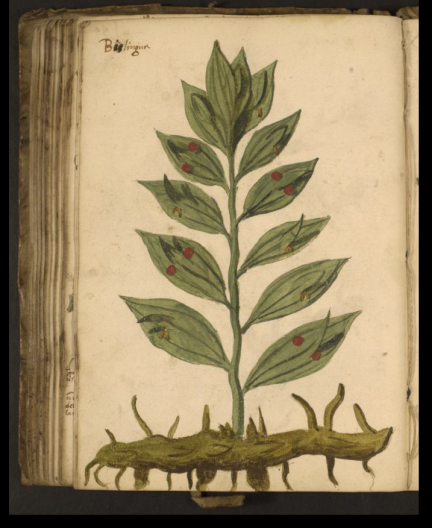I just learned about butcher’s broom, which has leaves that are not actually leaves. Are there other plants that have similar faux-leaves?
 Ruscus has evergreen leaf-like structures called cladodes which are actually flattened modified stems that do the task of photosynthesis just as leaves would. The plant does have leaves, but these are non-photosynthetic and very inconspicuous. An Italian herbal from the 1400s depicts it with the name ‘Bislingua,’ meaning another tongue, which is descriptive of the way the small flap (a bract) lifts up over the cladode. Names in other languages also refer to ‘two tongues,’ ‘below a tongue’ (similar to the species name hypoglossum) and more. There are helpful photographs and descriptions in Trees and Shrubs Online.
Ruscus has evergreen leaf-like structures called cladodes which are actually flattened modified stems that do the task of photosynthesis just as leaves would. The plant does have leaves, but these are non-photosynthetic and very inconspicuous. An Italian herbal from the 1400s depicts it with the name ‘Bislingua,’ meaning another tongue, which is descriptive of the way the small flap (a bract) lifts up over the cladode. Names in other languages also refer to ‘two tongues,’ ‘below a tongue’ (similar to the species name hypoglossum) and more. There are helpful photographs and descriptions in Trees and Shrubs Online.
Ruscus flowers and fruit grow right in the middle of the cladode, something which does not occur with true leaves. You can read more about Ruscus in an article by Walt Bubelis in the Fall 2018 issue of the Washington Park Arboretum Bulletin. You can also find the plant in the Arboretum’s Witt Winter Garden and in the Woodland garden. Danae racemosa, related to Ruscus, is also found growing in the Arboretum, is described by Roy Farrow in this blog post. Sallly Razelou’s article, “A Neglected Genus – Ruscus” by Sally Razelou (The Mediterranean Garden No. 54, October 2008) points out that the curious ‘leaves’ caught the attention of Theophrastus in 3rd century C.E.: “There are three trees peculiar to Mount Ida, the tree called Alexandrian laurel, a sort of fig and a vine. The peculiarity of the laurel is that it bears fruit on its leaves, like the ‘prickly myrtle’: both have their fruit on the midrib of the leaf.”
Examples of other plants with cladodes are Sciadopitys (Japanese umbrella pine) and Colletia paradoxa (anchor plant), garden asparagus, and asparagus fern.